How to Enable Dark Mode on Google Chrome
After the surprising absence of any kind of a Dark Mode option from the world’s leading internet browser, Google finally added a Dark Mode to Chrome. Dark Mode for Google Chrome is available across all devices, with the feature being known as Dark Mode on the desktop version of Chrome and Dark Theme on its mobile counterpart. Be it on your personal computer or your phone/tablet, if you want Chrome to go dark, it is now not only possible but also fairly easy.

As of Chrome 73 and Chrome 74, Dark Mode is available for both, MacOS and Windows respectively. With these updates, Chrome had a dark theme that responds to the currently configured system-wide theme built into it. Chrome’s Dark Mode is automatically triggered and enforced when the system-wide theme on Windows 10 or MacOS 10.14 and later is changed to Dark. If, however, you want to enable Dark Mode specifically for Chrome and leave the rest of your computer’s color palette unchanged, that too can be arranged. Here’s two different ways you can use Chrome in Dark Mode without changing your computer’s system-wide color theme:
1. Force Google Chrome to Enable Dark Mode on launch
Google Chrome does have a dark theme built into it – there just isn’t an interface for you to enable it from within the program. But, with a bit of very simple tinkering, you can force Chrome to always launch with Dark Mode enabled. This option is only going to work for those of you using Windows 10.
- Locate a Chrome shortcut – this could be on your Desktop, your Taskbar, or anywhere else on your computer, and right-click on it. If you’re using a Taskbar shortcut, you’re going to have to perform the added step of right-clicking on Google Chrome in the resulting context menu before you proceed.
- Click on Properties in the resulting context menu.
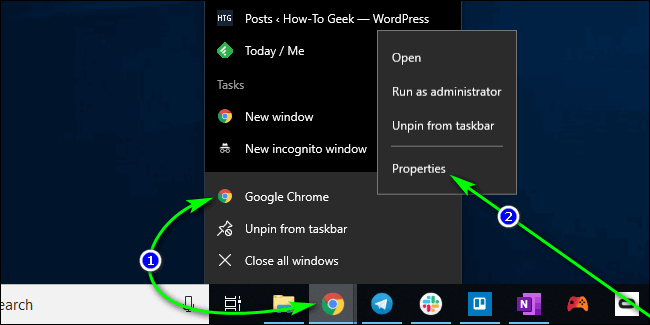
Right-click on the Google Chrome shortcut in the Taskbar, right-click on Google Chrome, and click on Properties - In the Target field, type the following, separated from what already existed in the field with a space:
--force-dark-mode
The Target field should now look something along the lines of:
"C:\Program Files (x86)\Google\Chrome\Application\chrome.exe" --force-dark-mode
Note: What’s in the field may vary slightly depending on the directory Chrome is installed in on your computer.
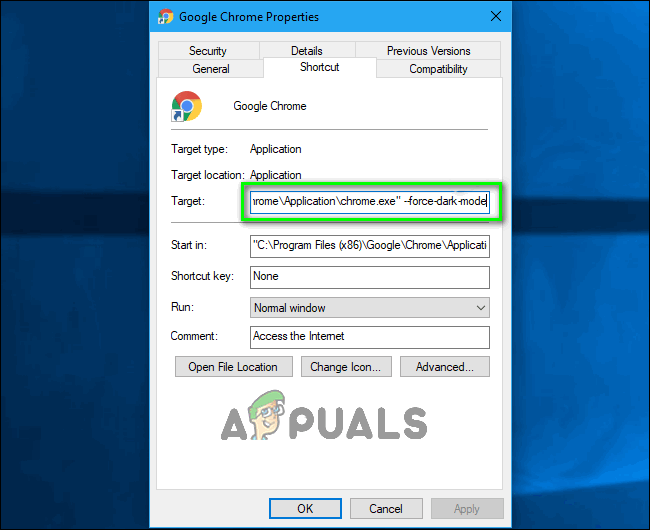
Add “–force-dark-mode” to the Target field - Click on Apply.
- Click on OK.
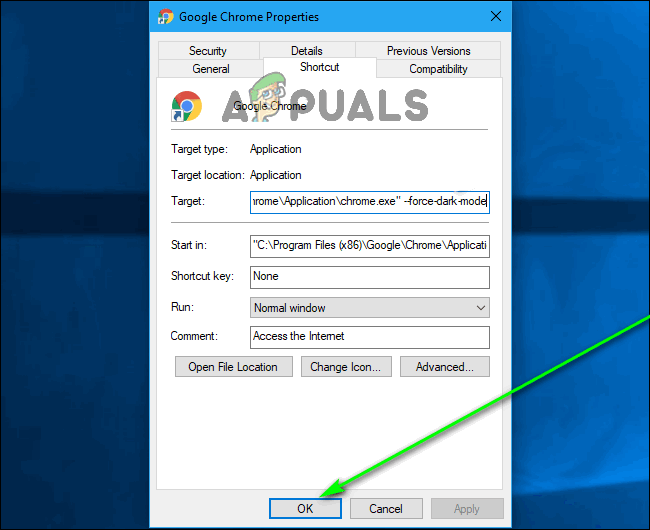
Click on OK - Launch Google Chrome and feast your eyes on the glorious darkness!
Hot Tip: The change only takes effect once you’ve restarted Chrome, so to save yourself some trouble and confusion, close Chrome before you begin.
2. Install a theme that’s Dark
One of the most appealing features Google Chrome has brought to the table since way back in the day is the ability to download and install themes that completely transform the way the internet browser looks. While a dark theme will leave some parts of Chrome (such as the Settings page) untouched, it will be applied to all of the parts you see the most, turning them dark (possibly even darker than Chrome’s actual Dark Mode). For someone on MacOS who can’t force-enable Dark Mode for Chrome or someone using an older version of Windows like Windows 7, that’s as good as it gets – and it’s good enough. To install a reasonably dark theme on Chrome, you need to:
- Launch Google Chrome.
- Make your way to the Chrome Web Store page for the Just Black theme.

The Just Black theme’s Chrome Web Store page - Click on Add to Chrome.

Click on the Add to Chrome button - Wait for the theme to be downloaded and applied to the internet browser.
The change will take effect immediately, and the Just Black theme is actually a fair bit darker than Chrome’s actual Dark Mode. To top it all off, Just Black comes directly from the people behind Chrome and not a third-party! You can also alternatively search the Chrome Web Store for other dark themes and pick out one you like more.
How to Enable Dark Theme on an Android device
Google has made Dark Theme available on all Android devices running Android 5.0 or higher. To enable the Dark Theme for Google Chrome on an Android device, simply:
- Open the Google Chrome app.
- In the top-right corner of your screen, tap on the More icon (represented by three vertically aligned dots).
- In the resulting menu, tap on Settings.
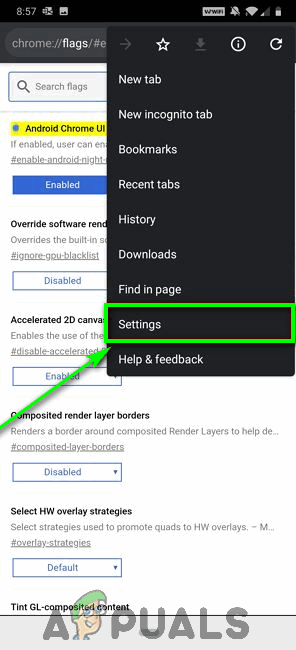
Tap on Settings - Tap on Themes.
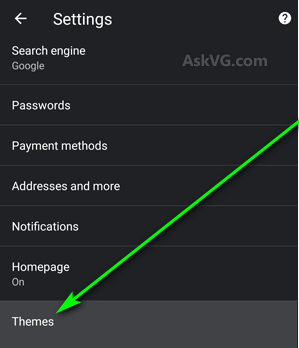
Tap on Themes - Tap on Dark to switch to the Dark Theme. The System Default option makes it so Chrome only enables the Dark Theme when your device is running low on battery and Power Saver mode kicks in or if the system-wide color theme for your device is changed to Dark.
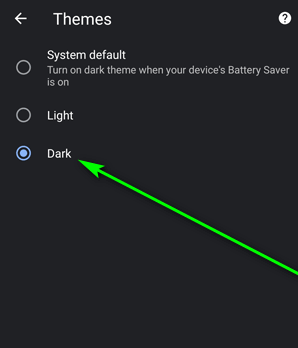
Select the Dark option
You will see the change take effect immediately.
How to Enable Dark Theme on iOS and iPadOS
Dark Theme is available on all Apple devices running on iOS 13 (or later) and iPad 13 (or later). Unfortunately, there is no way for the user to activate or deactivate the Dark Theme on Google Chrome independent of their device’s system-wide color theme setting. This means that if you want to enable the Dark Theme for Google Chrome on iOS or iPadOS, you are going to have to enable your iPhone or iPad’s Dark Mode.
There is, sadly, no way for you to force Google Chrome to switch to Dark Theme and disregard your device’s system-wide theme – the two are bound together and there’s no going around it. If you enable Dark Mode on your iPhone or iPad, Google Chrome will switch to its Dark Theme. And if Dark Mode is disabled, Google Chrome will go back to its usual, light self.





